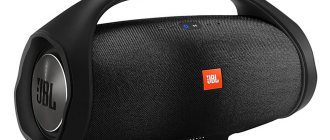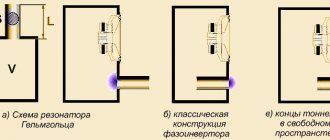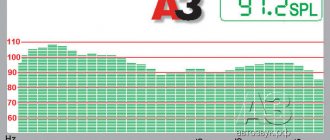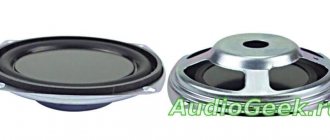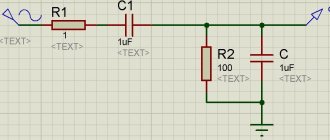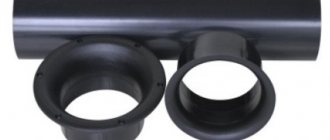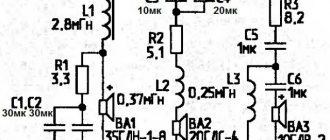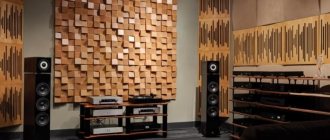The American company Martin Logan is well known to connoisseurs of AV products for its original products. First of all, we are talking about all kinds of sets or individual speaker systems for home theaters and professional recording studios. And, in addition, the brand name is directly and inextricably linked with electrostatic acoustics. It thundered thanks to the revolutions accomplished by its specialists in the field of sound technology. The first of these revolutions - technological - was the creation of advanced electrostatic emitters. The second – marketing – was expressed in reducing the cost of such high-tech products for the common consumer.
Martin Logan: milestones in history
And not the least role in this was played by the company’s founders, Gail Martin Sanders and Ron Logan Sutherland. The combination of their middle names gave the brand name Martin Logan.
Obsessed with the idea of creating ideal acoustics, which is not characterized by nonlinear and phase distortions, these people joined forces and began to form a team of audio professionals. The result of their efforts was the release of electrostatic acoustics MartinLogan Monolith, which became a real sensation at a number of exhibitions and the brand’s “golden ticket” to the world of acoustics.
The year 1997 was marked by another triumph in the Hi-Fi and High End industry for the unification of like-minded people. The new Statement E2 model, with its design, completely eliminated the usual ideas about electrostatic acoustics as something bulky and heavy. At the same time, it demonstrated incredibly impressive sound quality for that time. Two years later, Martin Logan took a step towards middle-income buyers by offering a Clarity model that was three times more affordable. It used the best technologies that the previous famous speaker model could boast of.
The beginning of the new millennium was marked by the formation of a new series of MartinLogan acoustics for home theaters. A wide variety of electrostatic speaker systems have appeared in the lines offered to audiophiles. Among them are subwoofers of varying power and cost, universal LRC speakers, center channel acoustics and satellites, representing electrostatic speaker technology. Also, connoisseurs of high-quality sound were presented with a number of models of designer systems and built-in acoustics using traditional dynamic drivers.
Features of Martin Logan's activities
The entire list of products of the popular American company is determined by some common features. These include the revolutionary nature of the technologies and innovative ideas embodied in them, the original design and materials used.
All equipment presented by engineers to audiophile audiences in a wide range of countries around the world is assembled by hand. In addition to thoughtful design forms dictated by a sense of style and technological specificity,
Thus, in addition to the clarity and realism of the sound picture of specific speakers, their owners make a choice in favor of build quality. The company's management pays special attention to this issue. A multi-stage assembly quality control system implemented in the company’s production allows us to guarantee the buyer exceptional reliability and sound quality of any product.
Specifics of Martin Logan acoustics
But, of course, the main secret of the popularity of the American company's acoustic systems is the specific technology of the electrostatic loudspeaker.
In this regard, any emitter of this type is formed by two metal stators in the form of gratings, between which there is a thin membrane with a conductive coating. A constant electrical signal is supplied to this diaphragm. The polarization of the stators changes according to the incoming sound signal shape. Sound is emitted by a moving membrane.
Compared to a dynamic type emitter, this design solution has a number of advantages. Among them:
- The lighter weight of the diaphragm compared to the speaker diffuser provides better detail in the sound of a music track or movie audio track;
- The absence of bending of the electrostatic acoustics membrane results in no distortion of the reproduced signal;
- Expressive deep bass with impressive aperture sizes (an example is the flagship MartinLogan CLX 25th Anniversary Edition);
- The crossover frequency of the low-frequency and broadband sections in the range of 200-300 Hz ensures the absence of distortion in the spectrum of reproduced high and medium frequencies.
Thus, throughout its existence, Martin Logan has completely transformed the acoustic environment through the release of its products. The company proactively raises the bar for acoustics quality and sets high standards that other participants in the AV market are equal to.
Review of the Martin Logan Electromotion ESL speaker system
We are quite familiar with Martin Logan speaker systems: we have tested floor-standing solutions from the Motion series with dynamic drivers and Folded Motion ribbon tweeters - from the smaller 20i to the large three-way 60 XTi, and we recently got acquainted with the bookshelf Motion 35 XTi. The solutions are extremely interesting, but Martin Logan is truly famous for its speakers with electrostatic emitters - that’s what we’ll start talking about today.
Most lovers of good sound know very well what electrostatic emitters are. Nevertheless, let's say just a few words about their design - for those who are not yet in the know. A thin membrane is stretched between two perforated metal plates - stators. Next, voltage is applied to the stators, and electrostatic interaction occurs between the plates and the membrane: like charges repel, opposite charges attract - everything is like in a school physics course. Accordingly, the membrane begins to be attracted to one stator and repelled from the other and vice versa. Its vibrations set the air in motion, creating sound.
This design has a number of advantages that distinguish it favorably from the speakers we are used to. For example, the electrostatic field between the stators is almost uniform, the membrane moves as a single whole - accordingly, a constant piston mode is ensured at all frequencies. The mass of the membrane is usually less than the air adjacent to it, which gives an almost complete absence of inertia. And so on. As a result, we get a very “flat” frequency response, a wide range, extremely low distortion...
True, “electrostats” have a number of, if not flaws, then very important features that are worth keeping in mind. Firstly, of course, the dipole nature of the radiation (in both directions simultaneously). This places additional restrictions on how the speakers are positioned in the listening room - they should not be placed along the walls, since the reflected signal will affect the overall sound experience. Secondly, the focus is narrow, so that the position of the listener also becomes of serious importance. We will talk about this in more detail below.
At the same time, “electrostats” were invented back in the 1880s in Germany. In 1922, tube amplifiers appeared, followed by the creation of the first commercial acoustic system using electrostatic drivers, which was intended for sound in movie theaters. Later, such acoustics began to be produced quite actively; in 1927, Hans Vogt created a push-pull electrostatic emitter, which has remained virtually unchanged to this day. However, by 1930, strong ferromagnets appeared, which gave a great advantage to dynamic emitters, which quickly supplanted their competitors.
But “electrostats” still did not go away and continued to develop. Initially, the problem was the lack of a suitable material for the membrane - aluminum foil was often used, which did not have sufficient strength and elasticity, plus it had a number of other disadvantages. By the middle of the 20th century, polymer films appeared, and already in 1953, Arthur Jansen received a patent for the first electrostatic loudspeaker built on their basis. Now, by the way, lavsan, also known as polyethylene terephthalate, is usually used as a membrane material.
The emitters have become much more reliable and practical, plus they have acquired all the advantages that we talked about above. True, they have no longer received mass distribution, but they have firmly established themselves in “advanced” audio systems for lovers of high-quality sound. It remained to solve one very important problem - the extremely narrow radiation pattern. It has not been possible to completely get rid of it to this day, but in 1982, at the Chicago Consumer Electronics Show, Gail Martin Sanders and Ron Logan Sutherland presented their CLS system, which they assembled in a garage, which solved the problem quite simply and elegantly - through the use of a curved panel.
The development won a design prize, and soon the Martin Logan company appeared, which brings us back to the heroine of today's review. Electromotion ESL is interesting primarily as almost the most affordable electrostatic acoustics. It is “affordable”, of course, only in comparison with other electrostatic models - this type of emitter has never been and will never be cheap. At the same time, the acoustics are equipped with a full-size XStat electrostatic driver measuring 86x22 cm, complemented by a large woofer, has all the advantages of this class of devices and is not without a number of interesting features, which we will discuss in detail below.
Specifications
| Claimed frequency range (±3 dB) | 44 Hz - 22 kHz |
| Sensitivity | 91 dB (2.83 V@1 m) |
| Horizontal dispersion | 30° |
| HF+MF emitter | electrostatic emitter XStat CLS size 86x22 cm |
| LF emitter | dynamic, ∅20.3 cm |
| Crossover Frequency | 500 Hz |
| Nominal resistance | 6 Ohm (compatible with 2, 6 and 8 Ohm amplifiers) |
| Recommended amplifier power | 20—300 W |
| Dimensions | 132×22×41 cm |
| Weight | 16.1 kg (each) |
| Cost at the time of testing | 280 thousand rubles per couple |
| Retail offers | find out the price |
Construction and design
The Martin Logan Electromotion ESL has only two finishes, both of which are black. But one has a glossy bottom, while the other has a matte bottom. We tested the first one.
The most noticeable part of the speakers is, naturally, the XStat CLS electrostatic driver. It has a size of 86x22 cm, so the emitting surface area is quite substantial - 1892 cm².
The design, as mentioned above, at first glance is not very complicated: two stators and a membrane between them. However, there are still many nuances; Martin Logan is actively developing the technologies embedded in it - in particular, the AirFrame case is designed to provide electrical and acoustic insulation, minimizing distortion caused by vibration and resonance. Even the holes in the panel are made in a special way, the manufacturer calls it MicroPerf - in general, the years since the victory at the Consumer Electronics Show have not been in vain.
At the same time, the main “feature” - CLS (Curvilinear Line Source) technology, that is, the curved shape of the drivers allows you to expand the radiation pattern - remains from those times. As a result, Martin Logan “electrostats” become a little easier to place in the room, the comfortable listening zone expands somewhat... But it still remains quite small, as we will see below.
Additionally, the drivers are angled slightly back, which helps prevent unwanted floor reflections.
The speakers have a hybrid design. Electrostatic drivers are responsible for the full range of mid and high frequencies from 500 Hz to 22 kHz, and the low-frequency register is reproduced by a speaker with a paper cone with a diameter of just over 20 cm, located in a “non-resonant asymmetric chamber”. The mesh in front of the speaker is removable.
Connectors are located on the back. Connection is supported using both clamp terminals and Banana or Spade connectors. At the bottom of the rear panel there is a connector for connecting the supplied power supply. Unlike the “bigger brothers” in the line, Martin Logan Electromotion ESL can work without external power, but you shouldn’t use it - it predictably does not have the best effect on the sound.
We have already spoken more than once about the Vojtko crossovers named after the developer, and they are also used here. The band separation frequency, as already mentioned, is 500 Hz. The bass reflex hole is located at the bottom and directed downwards.
Spikes are used as supports, which are supplied along with rounded attachments made of soft material. The latter will definitely come in handy at the stage of selecting the location of the speakers, during which they will have to be moved repeatedly. Well, then the choice remains up to the user’s preferences.
Connection
We started talking about connecting speakers a little higher - there are many options, everything is quite simple and convenient. But with placement there are a number of nuances related to the specifics of electrostatic emitters. As already mentioned, one of their key features is sound in both directions from the surface, and in antiphase. Accordingly, sound waves tend to be reflected from walls, meet at the surface of the emitter and cancel each other out. And this should be avoided - that is, place the speakers further away. Although even here there may be nuances: some owners of relatively small “electrostats” claim that they completely “forgive” the location of the rear wall of the speakers almost close to the wall.
The second point is, of course, that the level of horizontal sound dispersion is far from being the highest. Accordingly, Electromotion ESL, like the vast majority of models of similar acoustics, form a very compact area for comfortable listening. And it is very desirable to end up in it. We won’t describe the principle of placement; it’s better to borrow an illustration from the instructions, which shows everything quite clearly.
As always when talking about passive acoustics, we will mention all the equipment used during listening:
- stereo amplifier Lyngdorf TDAI-2170
- network player Aurender ACS100
The player is familiar to us; it has already appeared in several of our tests. Everything is simple with it: a high-quality source plus convenient control using Aurender Conductor software is what you need for comfortable test listening. Well, the Lyngdorf TDAI-2170 amplifier is a very interesting device in itself thanks to automatic room sound correction RoomPerfect, the Lyngdorf Intersample Clipping Correction system, and so on. A rather unique character played in its favor, in particular the ability to deliver a very “tasty” mid-frequency range. As we will see below, this is important for Electromotion ESL.
Sound and frequency response measurements
We traditionally begin our conversation about the sound of acoustics with subjective impressions and end with measurements. Let us immediately note that the testing was carried out in a specially prepared room - not in the same room where the photographs were taken. The first thing you notice is, of course, the highest level of detail in the mid- and high-frequency ranges, allowing you to notice the subtle nuances of tracks and indulge in the joys of so-called “analytical listening.” There is very little bass: it cannot be said that it is lacking, but it is presented extremely restrained - but with an excellent attack and without a hint of boominess. At the same time, the bass is perfectly “stitched” with the mids, the sound is extremely balanced and overall very impressive.
On the advice of colleagues, we started with “Spanish Harlem” by Rebecca Pidgeon, and it really was a great track to get acquainted with, showing the strongest side of Electromotion ESL - stunningly clean and transparent sound in tracks with a small number of playing instruments, the ability to emphasize solo parts and impressive processing vocals, especially female ones. Well, since the acoustics cope so well with female vocals, I wanted to listen to them in a denser mix. Aretha Franklin with her “I Say A Little Prayer” sounded simply extremely impressive against the backdrop of the most unobtrusive bass and light emphasis on the high frequencies - every hit of the cymbals and hi-hat sounded loud and clear, but without any harsh brightness.
Since everything worked out so well, it was decided to set a more difficult problem: Janis Joplin’s vocals are generally quite specific, and even more so in “Kozmic Blues.” And here Electromotion ESL was especially pleased: all the nuances of intonation and manner of performance, the incredible “creaky, hard and eardrum-scratching” voice were perfectly conveyed. The bass in this composition is important and occupies a fairly prominent place - and the tested acoustics also managed to show this despite the peculiarities of its sound in this register. And if you started listening to the great jazz and blues vocalists, it was impossible to do without Diana Krall. This time the song “Autumn in New York” was taken from the album released in 2022. And yes, the low, velvety voice also sounded great, as did the guitar and double bass accompaniment.
But man does not live by female vocals alone; one had to listen to men singing as well. It was decided to start with the composition “Hey Laura” by Gregory Porter, which immediately showed that the male vocals of Electromotion ESL are presented no less interesting and detailed than the female ones. Again, the saxophone solo at the end sounded great. The next was the imperishable standard “Autumn Leaves” performed by Seal, which made it possible to compare the sound of vocals accompanied by piano and orchestra.
Both options sounded very good, but still chamber mixes are the strong point of the speaker under test. To test and “reinforce” this thesis, the track “Someone You Loved” by Lewis Capaldi was chosen. And again, everything is very lively and voluminous, the piano sounds “note for note” and is completely in its place, the expression in the vocals is fully conveyed - in general, the composition evokes the maximum emotional response.
Then we returned to female vocals again, but in popular music. Miley Cyrus recently recorded an excellent album, and we listened to her duet with Duo Lipa called “Prisoner”. The acoustics once again showed that they “can handle bass” while maintaining the detail of vocal parts - it again sounds restrained, but the depth of emphasis on it depends on the mix. In general, the speakers will definitely cope with popular music, which is not surprising.
Julia Michaels with her “Uh Huh” at the very beginning of the track sounded almost perfect, then everything was also great, but the speakers were a little unable to cope with the noticeably forced bass during mixing. But how interesting literally a few high notes on the keys sounded, which, when listening on a not so high-quality acoustic system, may well not be noticed at all. Well, since it didn’t work out a bit with the accented bass, it was decided to listen to some double bass. The Zaz track “On Ira” was taken as an example. And again everything is very “good”, and again everything is good - we conclude that in “live” lineups the speakers can handle the bass parts quite well, just without unnecessary accents.
If so, let’s go into electronic music. To start, we take the already classic “Around The World” by Daft Punk. And we get an unexpectedly good result: bass lines and synthesizers are perfectly readable, vocals recorded via Talkbox are slightly brought forward and sound brighter than usual... In general, it’s very interesting - just with slightly different accents than most of the acoustics we’ve heard.
Inspired by such a pleasant result, we decided to listen to the legendary “Flat Beat” by Mr. Oizo. And here, of course, it became noticeable that electronic tracks built on a bass line are far from what should be played on Electromotion ESL. This was already clear, but it was necessary to check. By the way, a little later we listened to the same track on a slightly older hybrid Martin Logan model - the result was much, much more interesting. But we will not go into details now - there is a possibility that we will talk about this separately.
We continued with the “classic glam rock” of Kiss with their “I Was Made For Loving You Baby.” In general, everything was very good, but it was a bit of a shame for Gene Simmons - he’s a good bass player, but here the bass guitar sounded a little sluggish. It became obvious that, in general, the low-frequency range of the acoustics is quite capable, you can listen to something strongly tied to “chest blows” on it, but you should not expect vivid impressions. But in terms of volume and the so-called “virtual stage”, it shows itself simply superbly: the concert recording of “Too Many Friends” by Placebo demonstrated that Electromotion ESL is quite capable of creating the “immersive effect” that most concertgoers expect "
And we moved on to instrumental compositions. And the first was the soundtrack to the film “Amelie” called “Comptine D'un Autre Été”. Just a piano - nothing more. And everything sounded perfect, with every nuance preserved... Further - more: listen to “Take Five” by the Dave Brubeck Quartet. Once again, everything is excellent: from the saxophone of the composer Paul Desmond to the famous drum solo by Joe Morello. And how the rhythm sounds in the cymbals, how precisely all the musicians are positioned... In general, this melody has not brought so much pleasure for a long time.
From small trains to large ones. Listen to Concerto in B flat, Opus 40 No. 1: Allegro by Antonio Vivaldi and we are surprised that here, too, everything is very good with detailing and positioning: it is quite possible to imagine where and which group of instruments sounds, to highlight individual parts... The same can be said about the overture to Mozart’s “The Marriage of Figaro”: again -excellent positioning and the ability to highlight each part in your head, while the sound is very dense and conveys all the emotionality of the composition - a rare combination, I must say.
Well, in the end, we traditionally listen to something very quiet and calm, checking the operation of the acoustics at low volume. The song chosen was, to put it mildly, well-known - “Moon River”, but the performance was quite original - by a top model, the recent first lady of France and singer Carla Bruni. A gradual decrease in the volume of the track led to the fact that the low frequencies slowly but surely faded into the background, but the vocals remained as readable as possible until the last. At minimum volume, the result is a wonderful lullaby for those who love good sound and can afford not the cheapest acoustics. As you can see, the listening turned out to be quite extensive - the speakers being tested are quite worth it. We haven’t talked about everything, but it’s time to stop and move on to measuring the frequency response.
We draw the attention of readers that all graphs are provided solely as illustrations - they should not be used to judge the quality of the acoustics being tested. Measurement results can vary significantly depending on the position of the microphone, the audio path components used, the parameters of the listening room, and so on.
We carried out the first measurement in the near field - with the microphone positioned normal to the emitter plane at a distance of 1 meter. But in this case, it makes sense to pay attention to the resulting graph only as an illustration of the fact that listening to acoustics on “electrostats” from a short distance is not the best idea; you need to give them at least a little space. We move another meter away and we get a much more interesting picture.
Well, just another experiment concerning the position of the listener relative to the speakers. As we have already mentioned more than once, their horizontal dispersion is small. Let's try to place the microphone normal to the plane of the speaker, and then move it to an increasingly larger angle. The difference in the resulting graphs is obvious: the supply of the mid- and high-frequency range sharply weakens right before our eyes.
And we will finally move to the listening point at a distance of approximately 3 meters from the acoustics. And we get a graph that most fully illustrates the subjective listening experience. The low-frequency range is very uneven; one might suspect it of a tendency to “mumble,” but in fact nothing of the kind is observed. But mid and high frequencies are delivered very, very smoothly.
And, of course, we present a graph of the cumulative attenuation of the spectrum (also known as “waterfall”), also obtained at the listening point. It will allow us to evaluate the “contribution” of the room to the results shown and look at how prone the acoustics are to “humming” at various frequencies.
And here the result is extremely interesting. The “waterfall” is almost ideal - a slight “hum” is observed only at the bass reflex resonance frequency. Otherwise, the signal fades out very quickly - we apparently owe this feature to the feeling of “clarity” and “transparency” of the sound. Well, for those who want to get a little more information and make their own comparisons, we will show the “waterfall” obtained when the microphone was positioned at a distance of 2 meters normal to the plane of the speaker.
Results
The key negative side of all acoustics using electrostatic drivers is, of course, the price. At the same time, today's heroine is relatively affordable by the standards of the Hi-End world, but the sound provides extremely impressive. True, it is clearly not suitable for fans of deep and hard bass, but for lovers of chamber music, jazz and vocals it will bring a lot of pleasure due to stunning detail, a well-developed “virtual stage” and excellent separation of instruments. At the same time, the bass is quite present and even more so - it is served with a very good attack, it will not be able to simply “rock the party”. But you can sit in front of Electromotion ESL for hours, looking for new nuances in already familiar tracks - in fact, if only for this sake, it’s worth getting to know it better.
